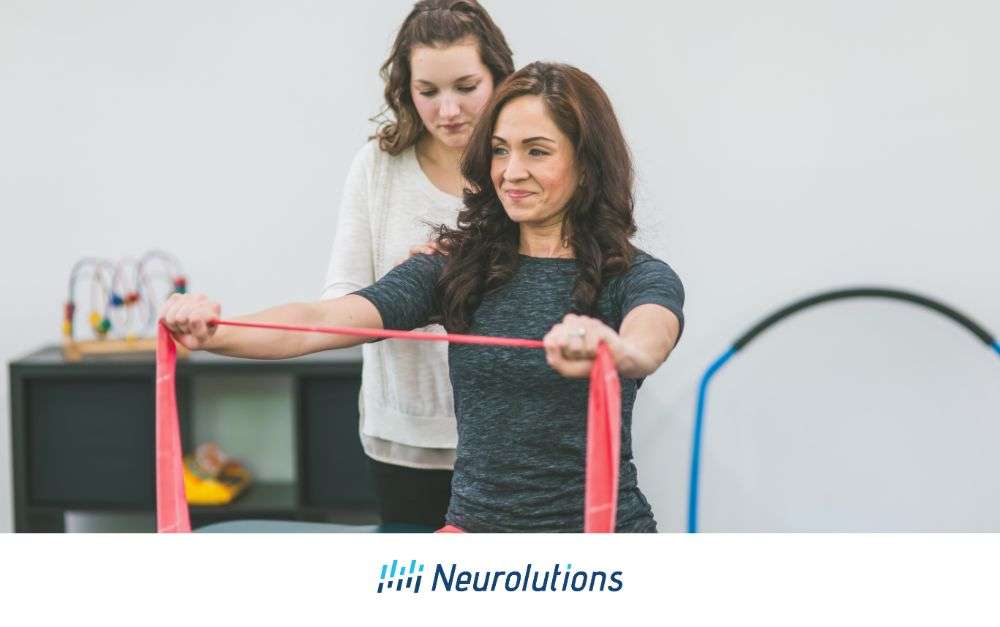To no surprise, stroke affects not only the survivor of the stroke but also close friends and family members. If you are a caregiver of a stroke survivor, you likely know that it is an overwhelming process to work through the unknown and often dark maze as you try to help your loved one on their path to recovery. Especially in the case of massive strokes in which an individual has lost major body functions and can not return to “normal life” as it was, the road ahead for the survivor’s spouse, child, parent, sibling, or close friend is not easy.
This article introduces a dozen tips for caregivers to help both the survivor and the caregiver going through the recovery process.
Top 12 Tips for Caregivers
- Be helpful, but encourage independence.
- Teach with patience.
- Break up tasks into simple and small steps of action.
- It’s not only about skill development; it is about confidence.
- Find the FUN.
- Encourage people to come close and not be afraid of the survivor.
- Try to stay organized.
- Don’t try to do it alone. Accept help.
- Set realistic goals. It is a prerequisite for hope.
- Do not ignore warning signs of hopelessness and despair.
- Keep your roles and routines alive as much as possible.
- Take care of yourself, too.
Tip 1: Be Helpful, but Encourage Independence
It is very normal to feel uncomfortable watching your loved one putting forth high effort and struggle while walking, talking, and thinking. Because of this perceived discomfort as well as the extra time that it takes to accomplish an activity, care providers may jump in early to complete a task. However, it is important to become at peace knowing that challenging your loved one to work through the restoration of function is what helps the brain rewire.
It takes perhaps millions of attempts to change the brain to promote recovery. If safety is of concern or frustration is peaking, or excessive attempts have occurred and yet failed, it is certainly acceptable to assist. It will take time to learn when it is appropriate to offer your assistance. When in doubt, reassure the survivor that they are working hard and then ask the survivor if they are ready for help!
Tip 2: Teach With Patience
Stroke can change how a person understands the world around them. It can also alter motor, sensory, and speech neural pathways and create havoc on basic functions.
These disruptions are highly frustrating for the survivor. It can also become frustrating to the caregiver who observes them struggling. Pieces of information may not fit in their brain like they once did, and incoming and outgoing messages are often inconsistent and inaccurate.
This means that information given to the survivor may need to be repeated several times before it clicks. The survivor may also make “simple” errors, drop items, be forgetful, act confused, or experience emotional ups and downs.
Sedonna, spouse and care provider for her husband Larry who suffered a stroke in 2019, can testify to this point. She states, “Don’t get uptight over having to repeat spoken messages. Be caring and gentle. [My husband] is the same person inside that he always has been and knows who he is and what he cannot do, even when he is trying his hardest to do what I ask of him.”
Develop a trusting, supportive relationship with your loved one by offering a calm, understanding voice absent of criticism and demeaning words. Jill Bolte Taylor, stroke survivor and author of New York Times bestseller My Stroke of Insight, writes in her memoir, “ I needed my caregivers to teach me the twentieth time with the same patience they had the first time.”
Tip 3: Break up Tasks Into Simple and Small Steps of Action.
In the past, the process of making a salad for lunch would have been a piece of cake. Now, expect that there may be confusion over the sequencing of what needs to happen for A to get to D.
Walk the survivor through each step one at a time as if they are learning everything from the beginning. Move on to greater complexity when they have mastered the basics. Think through what needs to occur in a task, from the environment to the person, to the demands of the task. Occupational therapists call this process, “activity analysis,” and it involves separating the parts of the whole to understand the client’s abilities and limitations with the goal of promoting successful occupational performance.
Tip 4: It’s Not Only About Skill Development; It Is About Building a Sense of Worth.
While relearning motor and cognitive skills is a critical component of rehabilitation to support the survivor’s occupations, a less discussed rehabilitation is addressing the mental health of the survivor.
Survivors not only worry about returning bodily function, but they also worry about being accepted. Let them know that they will not be abandoned because of what happened to them. The survivor is still very much loved and valued. Even if the survivor does not have all skills returned, build confidence in the survivor to know that they are worthy.
Tip 5: Find the FUN.
Life after stroke for both the caregiver and survivor can drastically be altered, if even temporarily. Days that used to be filled with normal household tasks, work/leisure, and attending venues such as a fair or a grandchild’s sporting event get filled with extra time spent on tending to the needs of the survivor, traveling in the car, medical appointments, and rehabilitation. This makes it very difficult to squeeze in “fun” activities that spark joy.
While it may not be realistic to do something “fun” every day, consider periodically scheduling an activity that both the care provider and survivor enjoyed together and is considered outside of the ordinary. Trying out a new restaurant, listening to a band, or shopping in a farmer’s market. It is also exciting to do something fun and spontaneous, such as making a last-minute decision to go out for ice cream after dinner.
Finding the fun does not necessarily mean scheduling a major outing. It also means trying to make “normal” mundane activities a little more enjoyable. An example of this could be creating a game while doing laundry in which the caregiver and survivor “shoot hoops” by throwing balls of socks into baskets. Look for fun opportunities to be a catalyst to a smile or even laughter. It may be helpful to try to integrate a hobby from pre-stroke life to help motivate survivors and caregivers. Most activities can be adapted to fit the skills of stroke survivors and the caregiver for participation in activity.
Tip 6: Encourage People to Come Close and Not Be Afraid of the Survivor.
Everyone reacts differently to traumatic, upsetting news such as the announcement of someone experiencing a stroke. Some people don’t know what to say or how to react so they avoid visits. As a caregiver, one of the most powerful things you can advocate for is connecting with your loved one’s friends and family and rallying for support and contact with the stroke survivor.
In-person visits are best so the individual does not become socially isolated, but gauge how long your loved one can tolerate the company. Even after the initial episode of the stroke with hospitalization, encourage others to stay in contact with them after they transition to home or other living environments. This will help them jog their memory of shared experiences, provide social enrichment, and work on communication skills. Make sure to reinforce visitors that bring positive energy rather than negative to help build a stronger mindset and outlook for both you and your loved one.
Tip 7: Try to Stay Organized.
Staying organized gets even more difficult than ever once medical appointments, medication monitoring, visits from home health, etc. enter the picture. Some tasks may have not been a role of yours in the past that you are now having to figure out, such as managing the finances or getting the groceries. Use sticky notes, put reminders on your phone, and put announcements/appointments in a calendar. Do not be afraid to tell others that because you have a lot more to manage than you once did, you would appreciate a non-judgemental friendly reminder to help you stay on track.
Tip 8: Don’t Try to Do It Alone. Accept Help.
There are two components to this tip: 1) recruit assistance from others and 2) learn from reputable resources.
You have likely heard someone state, “If there is anything I can do to help, let me know.” If the offer is extended, give them a job. It could be as basic as providing company while you run an errand. They can also run an errand for you! It may also mean looking into agencies that offer respite assistance to free you up.
The second component relates to learning what you can from physicians, therapists, books, and reputable stroke-related blogs or podcasts. Write down your questions and be sure you get them answered to your satisfaction of understanding so you can follow through. Ask for advice from others that have been through or are currently going through a similar circumstance. Write down your findings, take notes, and try your best to apply them in practice if it makes sense and would positively benefit your situation.
Tip 9: Set Realistic Goals. It is a Prerequisite for Hope.
Just as the Tip 8 there are, two parts to Tip 9 as well:
1) The most important goals that are set are not ones your therapist makes for you, but are goals set by you and your loved one. Realistic goals are considered attainable. This means they are not out of reach, despite them being progressively challenging.
2) Dr. Brene Brown in Atlas of the Heart advises to “reality check goals and pathways to them.” She writes, “Hopelessness stems from not being able to set realistic goals. Even if we can identify them, we don’t know how to achieve them. If we attempt to achieve our goals, we give up when we fail, we can’t tolerate disappointment, and we can’t reset.”
Preparing the survivor for the path rather than the path for the survivor is important. Recovering from a stroke is hard. There is no way around it. What is important to do is to get better at dealing with “the hard.” Holding onto hope and working towards realistic goals- or dreams!- is a key ingredient for a resilient mindset. We all fear pain and struggle, but it is often necessary for growth.
Tip 10: Do Not Ignore Warning Signs for Depression, Anxiety, Hopelessness, and Despair.
Emotional, personality and mood changes occur due to the impact of stroke on the brain. In addition to depression and anxiety, be aware of two specific experiences that can be present after a stroke: hopelessness and despair. Dr. Brown states, “Hopelessness and despair are emotions and experiences that pose serious threats to our wellbeing. Research on hopelessness arises out of a combination of negative life events and negative thought patterns, particularly self-blame and the perceived inability to change our circumstances.”
Decades of research suggest that extreme hopelessness and specifically desire are strongly related to suicide and/or suicidal thoughts. Early intervention for mental health involving a professional counselor, coach, psychologist, or psychiatrist is important. Interestingly, those with aphasia (i.e. communication difficulties) are at higher risk for depression than other stroke survivors, likely because of devastating communication barriers.
If you cannot get your loved one into intervention right away and they are not in immediate crisis where their life is in danger, try walking them through calming/anxiety-reducing activities like meditation, yoga, or imagery. Lend a listening ear. If your loved one is having difficulty communicating because of comprehension or expressive deficits, consult a speech therapist to find out alternative ways to communicate (i.e. augmentative communication, picture boards, or other strategies).
Tip 11: Keep Your Roles and Routines Alive as Much as Possible.
Take your loved one out in public so they can still experience life and interact with other people. Try to avoid pushing this on them too quickly as both you and your loved one will need to analyze response to stimulation, exertion, and stress tolerance.
If there were parks that you visited, television programs that you played, or card/board games that were regularly played before the stroke occurred, consider keeping these staples as a part of your routine.
If all else fails and there is not a safe or viable way to modify or adapt an activity for a role or routine, write down a list of activities that were on the “one-day” list. You may be surprised to find out that some of them are more ideal now to do than in the past being that you were occupied with other activities.
Tip 12: Take Care of Yourself, Too.
Providing care is a substantial commitment. It can be exhausting, frustrating, and worrisome. It is easy to lose sleep over nerves, sorrow, and grief. It is also common for depression to set in for the care provider.
Because of this, care providers must open up early to others- physicians included- about their feelings. Many care providers want to stay strong and not show their loved ones that they are hurting for the fear that it will only sadden the survivor more. It is fine to guard some emotion, but it also helps to talk about it in an objective and caring way. An example is provided: “I am going to leave for the afternoon for a little “me” time to take care of some personal things while Sarah helps out in our home. When I get back, I’ll be recharged and excited to be with you.”
If you do experience “caregiver burnout,” which is regarded as an overwhelming feeling of not being able to handle it anymore, take these steps: 1- acknowledge how you are feeling, 2- pat yourself on the back for your caring generosity, 3- look for resources that provide you with coping strategies to help you regroup, 4- when you feel clear-headed, look for breakdowns in your system consider solutions for managing it more effectively. This could involve hiring out help for respite, attending a social event to make sure you have a life beyond care providing, and seeking out support groups that offer specific advice for common issues.
Do not feel shame or guilt for taking personal time out for just you. Remember, it is very hard to be an effective caregiver if you are not taking good care of yourself.
Conclusion and Follow-Up Resources
Caregiving is a dynamic experience depending on the day and mood of the stroke survivor. As much as it can be difficult, there are also happy, rewarding moments that come along. When the caregiver sees positive changes in their loved one come to fruition or when the loved one offers an expression of gratitude, it can make you feel like you are making a difference. Hopefully, you found helpful guidance among the 12 Tips for Caregivers. If a strategy works after you put it into action, or if you have any comments or tips that you believe would help others who require caregiving recommendations, please leave feedback below.
Websites:
Stroke.org Caregiver Resources
Books Specific to Stroke and Caregiving:




